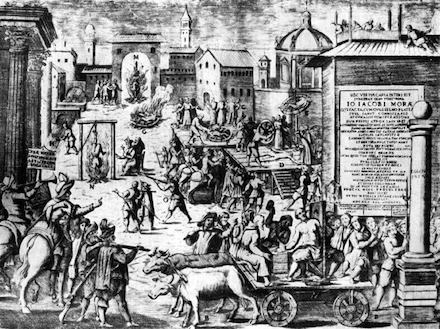On this date in 1630, a ludicrous disease panic sent two innocent men to the scaffold in Milan.
Terrified as their family and neighbors dropped dead around them of a raging bubonic plague outbreak, the surviving Milanese sprouted buboes on their brains.
Just days before the executions marked in this post, a city official named Guglielmo Piazza was noticed by some busybodies “strolling down the street writing from an ink-horn at his belt and wiping his ink-stained fingers on the walls of a house.” They promptly reported him not for misdemeanor property damage but for spreading plague poison, whatever that would be.
Investigators to their shame gave this accusation enough credence to interrogate Piazza under torture, a decision which obviously was tantamount to the execution itself. He broke he sealed his own fate when he broke and confessed, and sealed same for a misfortunate barber named Giangiacomo Mora whom Piazza was made to accuse.
Milan was proud enough of this obvious injustice to stand up an colonna d’infamia (“column of infamy”) denouncing both “poisoners” until a storm finally knocked the lying marble down in 1788. It read,
Here, where this plot of ground extends, formerly stood the shop of the barber Giangiacomo Mora, who had conspired with Guglielmo Piazza, Commissary of the Public Health, and with others, while a frightful plague exercised its ravages, by means of deadly ointments spread on all sides, to hurl many citizens to a cruel death. For this, the Senate, having declared them both to be enemies of their country, decreed that, placed on an elevated car, their flesh should be torn with red-hot pincers, their right hands be cut off, and their bones be broken; that they should be extended on the wheel, and at the end of six hours be put to death, and burnt. Then, and that there might remain no trace of these guilty men, their possessions should be sold at public sale, their ashes thrown into the river, and to perpetuate the memory of their deed the Senate wills that the house in which the crime was projected shall be razed to the ground, shall never be rebuilt, and that in its place a column shall be erected which shall be called Infamous. Keep afar off, then, afar off, good citizens, lest this accursed ground should pollute you with its infamy.
August, 1630.
Prior to the column’s overturning, the Milanese Enlightenment intellectual Pietro Verri wrote a meditation upon it titled Sulla tortura e singolarmente sugli effetti che produsse all’occasione delle unzioni malefiche, alle quale si attribui la pestilenza che devasto Milano l’anno 1630. Italian speakers can enjoy it here.
On this day..
- 1872: John Kewish, the last to hang on the Isle of Man
- 1938: Mikhail Viktorov, Soviet naval commander
- 1766: James Annin and James M'Kinzy
- 1595: Gabriel de Espinosa, the confectioner of Madrigal
- 1831: John Bell, age 14
- 1548: Seraphin d'Argences
- 1556: Joan Waste, in Windmill Pit
- 1924: Felix McMullen, bank robber
- 1946: Andrei Vlasov, turncoat Soviet general
- Feast Day of the Holy Maccabees
- 1997: Norio Nagayama, spree killer and author
- 1917: Frank Little of the IWW lynched


